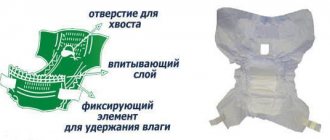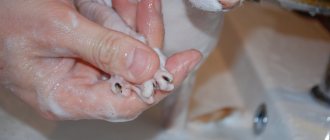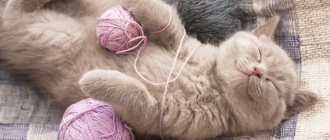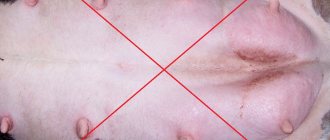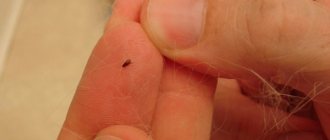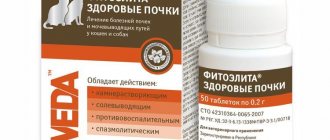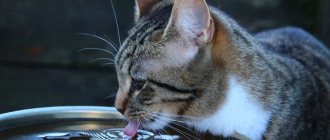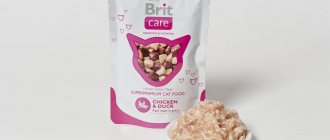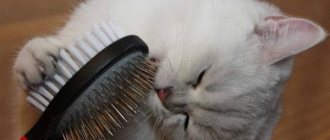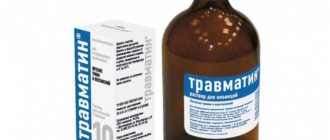Cats are one of the cleanest animals. They constantly lick their fur and wash themselves after eating. However, with all their love for cleanliness, animals often do not like and are even afraid of water, but the owner must carry out bathing procedures at least 3-4 times a year, using cat shampoo.
Why do you need to bathe your pets?
Hygiene procedures for such pets are always associated with stress. At the same time, not only the animal itself, but also its owner. Therefore, in order to bathe a kitten there must be a good reason for this. Among the main factors influencing the need to wash a cat are :
- preparing purebred pets for exhibitions or similar events;
- destruction of fleas or other parasites on the animal’s fur;
- the presence of a huge amount of dirt (especially light-colored pets);
- during the period when the animal sheds and hair falls out in large quantities;
In such cases, there is a special need to wash the kitten so that your pet is a clean and fluffy bundle.
Regular shampoos
This is interesting: How to independently determine the age of a kitten?
Useful video
- When you bathe a cat, do it with someone else - this will make it easier to hold the animal.
- Do not raise your voice to the animal and be extremely gentle.
- After shampooing, rinse the animal's fur thoroughly because it licks itself.
- If bathing is done to drive away fleas, then start with the neck - soap this part of the body, and only then the entire animal.
- The head and ears are washed last, and it is better not to wash them at all. Clean your ears with cotton swabs.
- Remember - the cat should not be overcooled.
Visually see how you can bathe a kitten with regular shampoo.
Features of bathing products
Cats make wonderful pets with unique coats. It has a structure that helps retain heat and regulate body temperature at the same time. Therefore, cats feel good at any time of the year, even in cold frosts or hot summers.
Due to these important nuances, it is not recommended to wash your cat with regular shampoo. Moreover, using non-special means can damage the structure of the coat and cause irritation on the animal’s skin.
Types of shampoos
There are many professional and universal products designed to bathe your pet. And when choosing them, it is better to pay attention to why you need it. There are shampoos: herbal based, with coloring properties that prevent shedding in animals, medical grade and dry products. And each of them has its own advantages of use, rather than when washing your pet with human shampoo.
Herbal shampoos are usually used to bathe pets, while cleansing the fur and removing unpleasant odors. Their peculiarity is their versatility and frequency of use, since they can be used to wash cats regularly without causing skin irritation.
Products with coloring properties are intended to be used to enhance the brightness of the color. They are often washed on the eve of an exhibition or other similar event where your cat will be the center of attention of many visitors.
© shutterstock
Shampoos that prevent shedding in animals are most often used in the spring or autumn, when their fur sheds. And if it falls out in large volumes, then it is worth using such a product rather than washing the cat with simple shampoo, so that this happens faster and does not create unpleasant consequences in the form of fur flying around the house.
Medical shampoos are intended for cats with skin problems. In such cases, exactly the same means are used that prevent the entry of bacteria and have a healing effect.
Special means
Dry cat shampoos are used to clean small dirt (mostly stains). Also, in case of panic in a pet, owners often use this method of bathing. And then there will be no questions about whether the cat needs to be washed with shampoo.
They look like powder that is applied to the animal's fur and combed out well. And if you use it, you need to take care of the quality of the product used. After all, it is worth remembering that you only comb it out with a brush, without water treatments, after which your pet, licking its fur , can swallow the remains. But the disadvantage of such products is their inability to cope with large amounts of dirt. Especially if they are parasites or pellets.
If there is no special shampoo, then problems with the animal’s skin may arise. Therefore, it is necessary to use only products that are intended for bathing cats only.
© shutterstock
Preparation
Bathing a cat involves three main stages: preparation, bathing and drying. The more time you spend preparing, the more predictable the process will be. Predictability is essential when bathing an animal that has teeth and claws.
Before swimming you need to prepare:
- Shampoo and, if possible, conditioner. Choose your products responsibly, as low-quality products can cause allergies in your pet. Products must be designed specifically for cats;
- Towels, preferably two;
- Comb;
- Bathing container. A basin or bathtub will do;
- Warm water. Water temperature is extremely important. It should be several degrees warmer than the cat’s body temperature, that is, 41-42 degrees;
- The assistant is a morally stable person, ready for adventure.
Before bathing, it is advisable to take care of your pet's manicure. This will protect both the cat and its owner. It is best to trim the claws with special clippers.
If your cat experiences stress during nail trimming, it is best to carry out this procedure the day before water procedures. Otherwise, an angry cat during a manicure session will cause even more trouble during bathing.
It is also advisable to brush your cat's hair before bathing. This is especially true for long-haired breeds. If the fur begins to tangle, then if it is not combed before bathing, it will become a real problem. If the wool is in a neglected state, it is better to cut off the tangles.
Don't try to untangle matted fur. This will cause inconvenience to the cat, and the result is unlikely to live up to expectations.
Brush your cat before and after bathing
Opinion of veterinarians and breeders
One of the most important indicators of the degree of skin protection is its acidity level. The condition of the skin, its integrity, and resistance to adverse environmental factors depend on this characteristic. In animals (in particular, cats) and humans, these indicators differ greatly. This is the main reason why veterinarians discourage washing pets with human-grade shampoo.
By neglecting the use of special pet shampoos, the owner of a cat can harm his pet. Long-term use of detergents intended for humans can, over time, lead to deterioration of the animal's skin condition, hair loss, itching, irritation and dandruff. In addition, regular shampoos often cause allergic reactions in four-legged pets.
Of course, occasional use of shampoo for people in most cases does not cause negative consequences. However, for regular washing you should still use a special product designed specifically for cats.
Is it possible to wash a kitten with laundry soap?
The most natural soap is considered to be laundry soap. It is valued for its good cleaning ability. But it is wrong to believe that it is suitable for bathing kittens.
Common people believe that they can wash cats with laundry soap. It’s better not to do this, but to choose a less aggressive one, with a low alkali content or a neutral PH level.
If there is no special shampoo and the kitten needs to be washed, a solution of laundry soap will do. It is suitable as an emergency measure. The cat may develop dandruff and itchy skin after a bath. Some cats experience hair loss, and allergic reactions are possible.
Laundry soap 72% from the era of socialism for a pet is a kind of poison. It is important to rinse the wool well so that the pet is not poisoned by soap components.
If you find problems after washing with laundry soap, you should immediately contact a veterinarian. He will tell you how to minimize the effects of alkaline attack on the skin.
Bathing process
Before washing your pet, it must be properly prepared for this procedure..
- Do not feed your pet for several hours.
- Trim your claws.
- Brush the fur if you have a fluffy cat.
Afterwards, you need to immerse the cat in warm water so as not to wet its ears. After all, if they get wet, your pet may catch a cold . The next step is to lather the fur with shampoo and rinse it off. In addition, it is worth remembering the amount of product used. After all, they are known for their foaming properties, due to which you don’t need to use very much of them. After bathing, dry the animal thoroughly with a towel to thoroughly remove excess moisture.
In addition to all the above features, it is important to remember that it is not advisable to wash a cat with baby shampoo. The reason for this may be external changes in the coat or even its color.
Previous
Question and answerHow to distinguish a cat from a cat - 5 methods
Next
Questions and Answers The smallest cat breed in the world - photo and description
Cleaning the premises after washing the dog
After water procedures and combing out fleas, the room should be treated. Parasites from the animal jump onto walls, rugs and get into cracks in the floor.
A type of flea that lives on animals
After the procedure is completed, they can again move to the pet. Therefore, the floor and walls need to be washed and disinfected. The rugs are washed with detergent.
After bathing, the dog needs new bedding. Fleas and their eggs remain on the old one, so the pet becomes infected with them again. If you can’t buy a new dog bed, you can wash it several times. All steps should be repeated after each washing and combing of the animal.
Can kittens be washed with baby shampoo?
Veterinarians do not recommend bathing kittens and adult animals in cases where there is no objective need for washing. In a situation where a kitten needs to be bathed immediately, but there is no pet shampoo available, the use of baby bathing products is allowed, as mentioned above. However, baby shampoos should be used in very limited quantities.
If the breeder is afraid of an allergic reaction to the shampoo in a small pet, it is better to refuse to use the detergent. According to experienced cat owners, you can bathe your animal in clean water without soap or shampoo.
It is only important to select the optimal temperature and water pressure, and during bathing, rinse the fur thoroughly, paying attention to the most contaminated areas.
Please note that it is forbidden to bathe kittens that have recently undergone vaccination. In addition, you should not wash weakened or sick animals. Restrictions on bathing kittens and cats may also be related to weather and season. So, in winter, as well as in the off-season, when the apartment becomes cold, washing animals is strongly not recommended in order to prevent the development of colds in them.
For information on how to properly bathe a kitten, see below.
This is interesting: How to calm a cat at night?
How to properly bathe a kitten
In order to gently bathe a small kitten, you should use a specialized shampoo, using baby product only as a last resort.
When bathing your baby, you need to be especially careful not to overcool the kitten, not to pour water into his ears and rub him thoroughly after washing, not to scare him or cause stress.
In the case of using specialized medicated shampoos, they are used strictly as prescribed by the veterinarian and in this case the pet is bathed according to the proposed scheme. As a rule, in this case we are talking about antiallergic drugs, since compositions for removing external parasites up to six months of life are not prescribed due to the high toxic effect of the drugs they contain on the body.
If the kitten is a show class and is planned to be presented at exhibitions and competitions in the future, then it is better to accustom the baby to bathing from an early age. Of course, you shouldn’t do this in the first or even the second month of life, but in three or four months the first procedure can be carried out.
If the kitten has recently moved to a new home, then washing should be delayed for at least two to three weeks to give it time to adapt.
It is also important to postpone bathing for at least a month after vaccinations.
It is important to carefully comb your pet before washing, since if the tangled hairs get wet, tangles are highly likely to form, which can only be removed by cutting.
If your baby begins to get stressed while combing his hair, then you should not immediately take him to the bathroom; it is advisable to give him time to calm down and tune in to a positive mood.
In addition, you can give him treats and play. Under no circumstances should you bathe a kitten immediately after a heavy feeding. You must wait at least two to three hours.
Warm water is filled into a container—a bathtub or basin—preferably at the animal’s body temperature, about 38 °C. To prevent the paws from sliding on the surface of the container, it is advisable to place a towel on the bottom. You can throw toys into the water, this will distract the kitten’s attention during the procedure. By the way, the whole thing should be done in 15 minutes. In this case, it is advisable to prepare the water for rinsing in a separate container in advance. You should douse your baby from a jug or ladle, and not frighten him with the noise of the shower.
The fur should be carefully lathered with the fingers of one hand, carefully holding the pet with the other.
To protect the ears, you can put cotton pads in them, but it is better to wash the face very carefully and last, trying to prevent water from getting into them - this is fraught with otitis media.
It is generally better not to touch the ears. If there are any problems, it is better to contact a veterinarian for cleaning, for example, wax plug. Especially if there is a suspicion of ear mites, this disease is called otodectosis and manifests itself in the formation of characteristic black dots inside the ear.
If after bathing and rubbing the kitten is clearly cold, then it is better to wrap it in a dry towel and carry it in your arms than to use a hairdryer. Firstly, the noise really frightens the baby, and secondly, hot air dries out the hair and makes it brittle.
It is advisable that the first procedure take place positively, in a playful atmosphere. After bathing and completely drying, you need to play with the baby and treat him with a treat and praise him.
Caring shampoos
This category includes slightly alkaline products for coat shine, silkiness, hair loss control, etc. Grooming products are often formulated with a wide range of vitamins and fatty acids to promote proper development and support of a thinning coat.
Fortified preparations.
Often very oily to the touch. With prolonged use (up to five baths) they show visible results - the coat becomes shiny and silky, and falls out less often. Optimally used with oral vitamins.
Preparations for oily wool.
Regulates the functioning of the sebaceous glands thanks to herbal extracts and antibacterial components.
Shampoos for dry wool.
Contains a secretion secreted by the sebaceous glands. Seals hairs, protecting against damage and ultraviolet rays.
The category of caring shampoos also includes “breed” shampoos, such as:
- Shampoos for sphinxes: presented on the domestic market by the company Ms.Kiss, which produces the “Graceful Sphinx” shampoo. Gently cares for the sensitive skin of cats of this breed, nourishes and prevents the occurrence of acne.
- Products for Persians: nourish the hair follicles, promote easy combing, and, thanks to smoothing the hair, prevent the formation of tangles.
Is regular shampoo harmful to pets?
How to properly wash a cat with regular human shampoo? Is it possible to use undiluted detergent on wool? Even the most gentle baby shampoo must be diluted with water before use. It cannot be applied to wool undiluted.
You need to dissolve 1 tablespoon of baby shampoo in 1 liter of water. This composition is applied to the wool and cleans it of dirt. It is important to rinse off the foam very thoroughly. To do this, the wool is washed three times with clean water.
It is known that cats do not like the process of bathing. This is due to the fact that when the animal gets wet, it freezes. Therefore, immediately after washing, the animal must be dried and covered with a towel. You should not dry the fur with a hairdryer; its sound can greatly frighten your pet. The cat should dry naturally. Towels need to be changed when they get wet.
How often should I bathe?
According to the standards established by the World Society of Animal Health:
- Domestic cats need to be bathed three to four times a year.
- If your pet is used to walking outside, then the frequency of bathing should be increased to 6-7 times a year. It is also necessary to clean the furry paws when he comes home from the street.
If your furry pet is dirty and a source of unpleasant odor in the apartment, it’s time to seriously think about solving this problem. Read from a special article on our website how to remove the smell of cat urine.
You shouldn’t get carried away and wash your cat often, especially if there are no detergents designed for this purpose, and you are looking for options on how to wash your cat if there is no special shampoo. Frequently repeated water procedures, and especially with alternative means, leads to a disruption of the pH level (skin fat balance) of the animal, and then the natural protection on the cat’s skin disappears.
How often to wash a cat depends mainly on the animal's lifestyle. If we are talking about a pet that can only see the street through a window, then there is often no need to bathe it. Two or three times a year will be enough to keep the coat clean and neat. If the cat likes to run around in the yard, then bathing procedures should be arranged more often - every 3-4 months.
But sometimes there is a need to plan an unscheduled trip to the bathroom.
- If your naughty guy stuck his nose where it shouldn’t and got dirty
The curious mustaches get into all sorts of troubles: cans of paint, bowls of glue, a dirty puddle, finally. If the cat is very dirty, then you should not wait 3 months until the next bathing day. It’s better to wash it, and quickly, before it stains the carpets, sofas and the owner’s favorite slippers.
Fleas and ticks can seriously ruin a cat's life. Anxiety, itching, allergic reactions - small bloodsuckers will turn the poor animal's existence into hell! No matter what means you use to combat the problem, you still cannot do without bathing with a special shampoo.
Note! Fleas are afraid of water. If you wet the animal's back first, they will instantly run to the head, and from there it is much more difficult to lure them out. Therefore, first of all, block the bloodsuckers’ escape routes and wet the neck, and only then the back, stomach, paws and tail.
We suggest you read: Dangerous symptoms and treatment of giardiasis in cats
- If the cat is going to take part in an exhibition
Bathing is a mandatory stage of preparation for such an important event. To make your cat's fur look smoother and silkier, use not only shampoos, but also special balms.
Do you think advice on how to wash a cat applies only to owners of adult animals? Not at all. A mother cat spends her days licking her kittens, but as soon as they reach one month of age, the person living nearby should also take care of the babies’ cleanliness. Although many veterinarians advise not to be too zealous with hygiene and not think about how to bathe a cat earlier than 3-4 months after its birth.
How to wash if the cat is afraid
A cat's fur protects it well from overheating and excessive cooling, and when wet, the air cushion between the hairs and skin fills with water, and the animal begins to freeze very much. This is why most pets do not like bathing and strive to avoid this procedure with all their might.
Read the article why cats are afraid of water and what to do about it.
In addition, the aroma of detergents is also unpleasant for cats; their delicate sense of smell is simply shocked by these odors. However, specialized cat shampoos take this criterion into account and do not contain fragrances.
If a cat is not accustomed to bathing from an early age, and is also afraid of water, then this procedure can become serious stress for both the pet and the owner.
In order to irritate your cat as little as possible, you should adhere to the following rules:
- It is advisable to invite someone from your household to help.
- Pre-comb the cat's fur and trim its claws.
- Under no circumstances should you shout at your pet; you should only speak in a gentle and soothing tone.
- It is better to place an anti-slip mat at the bottom of the bathing container.
- Remove from the surrounding area everything that could interfere, fall, or additionally frighten the cat, for example, bottles of shampoos and conditioners standing on the edge of the bathtub.
- Prepare several large dry towels.
- Prepare water for rinsing in a separate container; it is better to do it using a jug rather than a shower, so that the extra noise does not further frighten the cat.
- Fill a basin or bathtub with water at the animal’s body temperature so that its surface is slightly higher than the level of the cat’s belly.
- It is worth starting the procedure when the pet is relaxed and calm.
- Going into the bathroom with him, hold him in your arms for a while, talking affectionately.
- Then carefully place in water.
- While your assistant is holding the cat, quickly lather the fur with cat shampoo.
- Then thoroughly but quickly rinse your pet from the ladle at least three times.
- Place the cat on the bathroom floor and rub him well with a towel.
- Then wrap it in a second dry cloth and leave the bathroom.
- Carry the cat in your arms, calming and talking to him affectionately.
- Do not use a hairdryer under any circumstances, this will only frighten your pet even more and discourage him from bathing forever.
- Once the animal is dry enough, lower it to the floor and let it lick itself.
- Play, talk affectionately, offer the cat a treat, praise.
What to do if you don’t have any pet supplies on hand?
In cases where the pet needs immediate washing, but there is no special shampoo on hand, it is allowed to use a product intended for children. High-quality baby shampoos do not contain fragrance additives, harmful surfactants or other unsafe chemical ingredients.
The fact that the product is suitable for washing animals is indicated by:
- the most simple and understandable composition;
- absence of additives that can cause allergies;
- neutral aroma.
The best shampoo for bathing your pet is a shampoo intended for children under three years of age. It is believed that such detergents have the most gentle effect on the skin, thoroughly and gently cleansing it of impurities and sebum.
How to wash a dog with tar soap
How often can you wash your dog and puppy with shampoo?
If you find fleas on your dog, you can try using a natural remedy to get rid of the parasites. It is better to comb out fleas after bathing your pet. To wash a puppy you need a basin; for a large animal, a bath is suitable. You will need a fine-tooth comb, a flea jar, a bath towel and dog soap.
To wash your dog, you need to follow these steps:
- Place your pet in the bath.
- Turn on warm water and rinse the dog with it.
- Beat the foam separately and lather the pet's entire body, working on the stomach, armpits, and paw pads. It is important to ensure that soap suds do not get into your ears, mouth or eyes. Soap can begin to burn mucous membranes.
- Rinse the dog with clean water and soap again, leaving the foam for 5 minutes.
- Rinse off the foam and remove the fleas with a comb, placing them in a jar with a high neck.
- Rinse your pet with water and dry thoroughly with a soft towel.
The procedure must be carried out every 3-4 days to get rid of fleas.
The procedure for washing a pet using a product with tar
How to wash a cat: advice from veterinarians
Veterinarians generally do not recommend washing animals frequently.
- The procedures are recommended for adult cats during spring molting so that less fluff accumulates in the stomach and does not cause constipation.
- Cats can only be washed with regular shampoo when nothing else is available. But you need to choose dermatological compositions based on soap root, without lauryl sulfates, dyes, fragrances, and with a small amount of PVA.
- Tar product is used as a flea prevention for kittens from 8-10 weeks of age. After the procedure, the animal cannot be fed for four hours; water must be given. Treatment is carried out no more than once a month. Apply the soapy liquid for 3-5 minutes, then rinse with cool water.
- Do not wash cats with hot water; the functioning of the sebaceous glands is disrupted. It is important to avoid foam getting into your ears, eyes, and mouth.
- Hypoallergenic baby washes can be used for cats if special shampoos are not available. They are not so concentrated. They must be diluted with water. Children's liquid cream soap is safer and better in composition.
- It is important that there are no wounds or scratches on the kitten’s skin. If possible, it is better not to wash a dirty pet; just wipe it with a soft, damp cloth to remove heavy dirt. After such a procedure, he will not get sick, he will get better on his own within a couple of days.
By properly caring for their pet, owners save themselves from unnecessary hassle and trips to the veterinarian. A fluffy meowing pet is not a toy, but a living creature that does not need to be constantly washed with shampoos, they are harmful to it. It is important to protect kittens from water procedures after vaccinations; they are especially vulnerable.
Precautions when using tar products
Thanks to its simple composition, tar soap is not as toxic as many modern household chemicals. Preservatives, dyes, components for abundant foaming negatively affect the well-being of the pet.
Some manufacturers of household chemicals add Diethylene Glycol, which is toxic to animals, to soap with tar. When buying a product, you need to carefully read the composition. This component should not be present in the product. The substance causes food poisoning.
When washing your dog with soap and tar, you need to be careful not to get it in your mouth, eyes or ears. The strong odor may cause dizziness in some people. Therefore, during water procedures, the door to the bathroom should be kept open.
Tips for bathing cats
If you need to wash the dirty cat as quickly as possible, but there is no specialized product nearby, sometimes you can still bathe cats with human shampoo. Then veterinarians ask you to wash your furry friend with baby shampoo or use adult cosmetics.
It is important not to forget that:
• the composition should contain a minimum amount of fragrances, and the smell should not be strong;
• it is important to rinse off the product completely;
• it is advisable to use cosmetics with the least amount of surfactants.
Important
: Human hair care products should not be applied to a cat's coat! Prepare a solution - one tablespoon of shampoo is enough for one liter of water. You can add half a spoon of hair conditioner - this will help the animal’s thick and fine coat retain its best qualities.
The solution should be rinsed with water three times, as the residue may have a detrimental effect on the cat. In addition, the animal will lick itself, and it is important that the chemical does not end up inside the pet's body.
The kitten can be lightly washed with soap without a strong odor.
If your pet mostly stays at home, and going out into the world is very rare or even an unrealistic event for him, then you do not need to carry out the washing procedure often. You can swim once every three to six months. After water treatments, the wool should be dried with a towel.
There are times when a cat refuses water treatments, and persuading him to take a bath is more expensive. Then dry shampoo will come to the rescue. A powder-like product is applied to the contaminated area and then combed out.
Sometimes bathing animals is generally prohibited - for example, if your cat is of a noble age. Old cats experience more stress than young cats. Washing can shake their nervous system. You should avoid taking a bath if your pet has recently undergone surgery. Veterinarians do not advise washing an animal if the room is not warm enough - because then the pet may catch a cold.
Bathing is always stressful for your little friend, which means you need to prepare for water procedures in advance. You should not feed your pet several hours before washing. It is better to trim long nails and comb the fur. The water in the bath should be warm, at room temperature, and not reach the animal’s ears. Bathing is completed simply - the fur is completely dried with a towel.
Why wash your cat
Cats lick themselves very often, completely several times a day, and in between they will definitely run their tongue over their paws, tail or sides. However, in some situations, bathing your pet is inevitable:
- Before a competition, show or exhibition. In this case, the animal owner, as a rule, has all the necessary specialized hair care products.
- In case of heavy pollution, for example, after a long walk in the rain.
- If substances come into contact with the fur that may be hazardous to the health of the pet.
- With heavy shedding. This is especially true for representatives of long-haired and some semi-long-haired breeds. These pets often suffer during such periods from excessive ingestion of hairballs.
- For medicinal purposes, in particular, when removing external parasites.
However, it must be remembered that excessive bathing can lead to disruption of the protective lubricant and, as a result, to loss of shine and health of the coat. Three to four times a year is the optimal number of procedures.
If the cat often walks, especially at the dacha in the summer, then you can simply wipe it periodically with a damp cloth, and wash only the paw pads every day.
Similar to the need for bathing, there are situations when this procedure is unacceptable:
- If the animal has recently undergone surgery. Washing should be delayed as long as possible, even after sutures and bandages are removed.
- The advanced age of the pet also imposes a ban on bathing. For an old cat, this is too much stress and the risk of getting sick from hypothermia.
- You should also not bathe a pregnant or lactating cat. She doesn’t need foreign odors, additional stress or hypothermia.
- You should postpone the procedure even in the cold season, especially if the house is not too warm or there are drafts.
Which is better to use?
So, given that human shampoo cannot be used regularly on animals, you should pay attention to special pet products for washing and bathing. Today, manufacturers offer a wide range of different pet shampoos, including such types of products as:
- dry shampoos;
- anti-matt shampoos;
- antiparasitic (against ticks and fleas);
- medicinal (anti-inflammatory, antifungal, antiseborrheic);
- carers.
Dry products are optimal for animals experiencing severe stress from bathing. Such shampoos are available in powder form, which must be applied to the pet’s fur, and then combed out thoroughly. During its action, the powder will absorb impurities and excess sebum, which will restore the cleanliness of the coat and the attractive appearance of the animal.
Anti-matt products are necessary for long-haired cats and female cats. The composition of such products includes special components that ensure easy combing of the coat, strengthening the hair follicles, and preventing the hairs from becoming lumps and tangles.
Antiparasitic or insecticidal agents (against ticks and fleas) are required for animals that spend a significant part of their time outdoors . They contain disinfecting components that prevent the animal from becoming infected with skin parasites. However, it is not recommended to use such products for a long time and regularly, as they can cause dry skin.
Medications are used depending on the indications. As a rule, such shampoos are prescribed by a veterinarian when any skin disease is detected in an animal. Their use makes it possible to reduce the manifestations of the disease, restore the initial immunity of the skin and its protective functions, and normalize the functioning of the sebaceous glands. Just as in the previous case, medicinal detergents cannot be used for a long time.
Grooming types are recommended for constant use when washing and bathing animals. They often contain all sorts of useful additives that provide high-quality and gentle hair care. The use of such detergents allows you to strengthen your pet’s coat, making it shinier and thicker.
In addition, high-quality grooming shampoos reduce hair loss during the shedding period.
An important feature that any high-quality pet shampoo for kittens and adult animals should have is absolute hypoallergenicity . Not only the pet’s comfort during bathing, but also the health of its skin depends on this condition. To prevent your cat from developing skin allergies to shampoo, preference should be given to products from well-known brands. On the modern market, these include such manufacturers as: Trixie, Goodman, Bioflor, Agrovetzashchita.
Why is “human” shampoo not suitable?
If suddenly there is an urgent need to bathe your pet, is it necessary to buy a special shampoo for this, or will the one we use ourselves be suitable? Shampoo intended for humans is not suitable for cats. There is more than one reason for this.
- Cats have a different skin structure.
- Their pH level is higher than that of humans.
- As a last resort, you can use gentle shampoos. They will not damage the protective layer. If you damage it, you can harm the animal. Before the layer is restored, the cat’s body will be vulnerable. It can easily become infected.
- After the procedure, it is very important that the pet is warm. This is especially true for kittens.
how often can you wash your cat
Dry shampoo for cats: pros and cons
Shampoos for cats and kittens can be regular (to remove dirt and foreign odors from fur), caring (bleach white fur, improve the condition of the coat and skin), medicinal (anti-flea, antifungal). They are available in liquid and dry form. Shampoo in the form of powder, mousse, spray or foam is a good alternative to liquid detergents.
Dry pet shampoos are very popular. Their demand is due to the following qualities:
- Ease of use. Powder, spray, mousse or foam is applied to the pet’s fur and after a certain time is removed with a brush.
- No need to use water , which is especially important if your four-legged pet has hydrophobia.
- Possibility of use in any conditions. Dry shampoo can be used all year round, regardless of the air temperature in your home. It is convenient to use while traveling.
- Painless and easy untangling of tangles thanks to the antistatic component.
- It is impossible for water to get into your pet's ears.
- Possibility of use in all categories of animals, regardless of age, health characteristics and physiological state.
- Possibility of frequent use.
Dry shampoos have several disadvantages:
- they are not able to cope with severe pollution;
- their particles are noticeable on dark wool;
- Inhaling the product may cause shortness of breath and spasms in your pet.
(4
rated
5.00
out of
5
) Loading…
Mr. Cat explains: is it possible to wash a cat with human shampoo?
In order to wash the cat painlessly for everyone, this should be approached responsibly, training the pet in a timely manner and preparing all the necessary means. Sometimes you don’t have “cat” shampoo on hand, and then the question arises: is it possible to wash a cat with human shampoo?
Veterinarians and breeders are categorically against the use of “human” shampoos for pet care.
They give the following arguments:
- The hair structure of cats and humans is too different. Cats have fewer glands that secrete sweat and oil. Therefore, human shampoo contains a much higher content of surfactants, which in such quantities simply dry out the skin and fur of pets.
- The epidermis (i.e. the upper part of the skin) of a pet is much thinner and more sensitive than that of a person.
- The value of the acidity index also differs. A cat's pH is 4-6, a person's is from 3 to 4.5.
- Cats have two types of hair: guard hair and down hair. There is an air cushion between them, so a cat’s coat is a whole system that needs very delicate influence (we write more about the structure of hair in cats at the end of the article, so read to the end, there is a lot of useful information there).
- The presence in human shampoos of aromatic and often strong-smelling substances, microscopic additives for shine or tint, harmful to cats.
- Many “human” detergent compositions contain extracts from herbs and other natural components that can cause allergic reactions in cats.
Of course, if you wash your cat with “human” shampoo once, and with all the precautions, then the harm will be minimal. The main thing is not to do this systematically; it is still better to purchase a specialized cleaning composition for your pet. After all, manufacturers develop pet shampoos taking into account the characteristics of the coat, and products for humans, when used regularly, can cause irreparable harm to the appearance and health of a cat. The wool will fade, lose its natural shine, become dull and brittle, and will mat and form tangles.
In what situations is bathing undesirable?
Despite the fact that bathing does not harm, and is even beneficial, there are still some nuances in which it is not advisable to bathe an animal. This especially applies to situations where there are no means for bathing cats and you are looking for options on how to wash your cat if there is no special shampoo.
Under what circumstances should cats not be bathed?
- when the animal is already old;
- if the cat is pregnant;
- when a cat is a nursing mother;
- if you have recently had surgery or suffered a serious illness;
- when the house is very cold or drafty (the room temperature should be at least 22 degrees);
Pregnancy
Is it possible to bathe a pregnant cat? There is no definite answer here, because water procedures during pregnancy do not have any direct effect on the future offspring or the health of the animal. On the other hand, stress is not desirable for pregnant cats.
Our advice on how often to bathe a cat does not apply to expectant mothers.
When bathing your pregnant pet, consider the following points:
- any trauma, including psychological, can affect the health of the offspring;
- It is better to replace regular bathing with the so-called “dry shampoo”. It is similar to powder, rubbed into the coat and then combed out;
- Veterinarians recommend bathing pregnant cats only if there is a possibility of a substance hazardous to health entering the digestive system (it settles on the fur, and the tailed cat begins to lick itself out of habit).
So bathe only when absolutely necessary, or if the animal loves bathing and tolerates this procedure calmly.
Features of cat fur
Cat fur has a number of specific features and is the thickest among all types of domestic animal coats.
The number of hair follicles per square millimeter of a cat's skin exceeds 200-300 units. For comparison, the most famous Merino sheep has this number of 165. Although now there are many unique breeds with original and even bare wool, for example, various Sphynxes.
Merino sheep
Hairless cats have to be bathed even more often than wool cats, since the hair of the latter has the properties of a kind of protection from external influences and is able to clean itself to some extent.
A cat's hair consists of the following structures:
- Cordiform layer. This is the main, central part of the hair. It is a cluster of keratinized cells, between which there are air cells. If the hair is mature, then in place of the core a cavity is formed in the upper part and at the base, enclosed in a protective cocoon.
- Cortical coating. This is the middle layer. It consists of axial hairs and spindle-shaped cells. They are tightly welded together and reliably cover the core, thereby ensuring the rigidity and elasticity of the cat's coat. This is where the pigment responsible for the color of the animal is located.
- Cuticle or scaly protection. It covers the cortex and consists of elongated flat keratinized cells that do not have a pigment composition. Their function is only to prevent the penetration of harmful substances, moisture, and pathogenic bacteria. In addition, the healthy shine of a cat’s fur depends on the quality of the scales, their microscopicity and tightness of fit to each other.
On all layers, cat hair contains sufficient keratin to ensure water resistance to the cat's coat.
Another feature of the hair is that all its cells are already dead and keratinized. Only the follicle is alive. It is the hair follicle that needs regeneration. The cat is special; its complex structure has been formed over the years of long evolution.
The strength of the hair root and the healthy shine of its wool part depend on the quality of the follicle. Next to the follicles are sebaceous glands and fan-shaped muscles. The former are responsible for lubricating the hairs, and the latter raise the hairs when necessary. Two hairs grow from each hair follicle - one guard (covering) and the second downy. The guard hair is long and straight, ending at the end with a kind of cone. Based on thickness, it is divided into four classes. The thickest and longest is located rarely, it is a guide.
The length and thickness of the guard hair determines the type of cat's coat. Their strength and straightness eliminate waviness. The thinner and weaker the integumentary hairs, the curlier the cat.
Downy hair is much shorter and thinner, wavy-shaped. It either does not have a middle layer, or it is very poorly developed.
Thus, a cat's hair grows in microscopic tufts, forming complex groups consisting of one guide, two or three regular guard hairs and from six to fifteen down hairs.
The hair follicles are located in the epidermis layer not perpendicularly, but at an acute angle, so the guard hairs always cover the down hairs, protecting them. That is why the lower the ambient temperature in the breed’s habitat, the thicker the undercoat (more fluff) of its representatives.
Over the years, many varieties of cats have mutated, and man has also created new selections and breeds that differ, among other things, in the type of coat: short (regular and Siamese-oriental group), long, semi-long and its complete absence (hairless or hairless pets).
In order to effectively care for a cat, it is necessary to select the shampoo that is intended for a specific type of coat. Although bathing a cat is not an urgent need. Nature itself has taken care of protecting the animal’s skin due to the air layer and natural lubrication, and the pet can carry out hygienic cleaning on its own with its long and hard tongue.
Features of cats' fur
So, if you are in doubt whether you can wash your cat with regular or baby shampoo, we will reassure you - nothing bad will happen from a single bath. Your pet will be alive, healthy and attractive, but with constant use of inappropriate products, the fur may become dull and begin to break, skin irritations will appear, and in long-haired cats, tangles may appear.
Therefore, it is necessary to select and constantly use a special shampoo for cats in accordance with the type and length of hair.
In general, cats have the thickest fur of any animal species domesticated by humans. On one square millimeter of their skin, up to 200 hairs grow, while, for example, the thickest-haired Merino sheep grows up to 160.
Of course, breeding has significantly modified the fur of representatives of many breeds, even to the point of its complete absence, as, for example, in sphinxes. By the way, this does not mean that hairless cats do not need to be washed - they should, and even much more often than ordinary ones.
Breeds also differ in coat length, and currently there are four known groups of cats based on this trait: longhaired, semi-longhaired, shorthaired and shorthaired Siamese-Oriental. Manufacturers of professional cosmetics for animals offer a wide selection of products from which you can choose a product that is suitable for your pet.
Is it possible to bathe a cat in the heat?
If a cat suffers from the heat in the apartment in the summer, the owners may want to give it a bath to refresh it. But frequent bathing, as is already known, can be harmful. Therefore, “refreshing procedures” are recommended to be carried out as follows:
- place a wet towel within reach of the animal so that it can lie on it or wet its paws
- spray the cat with water from a spray bottle
- wipe the cat's head and paws with a damp cloth
And even in these cases, the water should not be very cold so that the cat does not catch a cold.
Is it possible to bathe a cat during heat?
You can bathe a cat during a difficult period of estrus; the procedure will not harm her. Moreover, some owners have noticed that after bathing their pets are so busy licking that they even calm down for a while. But this does not mean that water procedures can be performed every day. They resort to them only once.
Bathing during heat distracts the cat.
